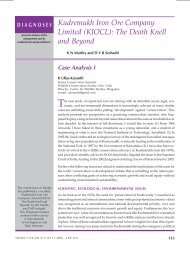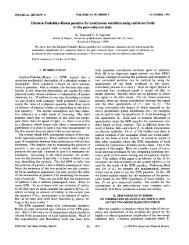Phase Transfer Catalysis - Publications of the IAS Fellows
Phase Transfer Catalysis - Publications of the IAS Fellows
Phase Transfer Catalysis - Publications of the IAS Fellows
You also want an ePaper? Increase the reach of your titles
YUMPU automatically turns print PDFs into web optimized ePapers that Google loves.
Model<br />
Model A<br />
Table 3. Summary <strong>of</strong> Models for Homogeneous Solubilization*<br />
Step(s) Contributing<br />
to Overall Rate<br />
Characteristic<br />
Features <strong>of</strong> <strong>the</strong> Model<br />
Organic phase reaction Constant Q+ Y- concentration<br />
Pseudo-first-order rate<br />
Model B Organic phase reaction<br />
and ion exchange<br />
Model C Organic phase reaction, ion Rate <strong>of</strong> solid dissolution<br />
exchange, and solid dissolution important at low values <strong>of</strong> ksla<br />
Model D Organic phase reaction, ion Mass-transfer limitations<br />
exchange, solid dissolution, and<br />
mass-transfer steps<br />
slow down reaction<br />
*Adapted from Naik and Doraiswamy (1997).<br />
change step. Considering a volume reaction model, similar to<br />
those developed for gas-solid reactions, <strong>the</strong>y developed <strong>the</strong><br />
following equations for <strong>the</strong> PTC cycle<br />
0 50 100 150 200 250<br />
time (min)<br />
time (min)<br />
Figure 10. Comparison <strong>of</strong> models for homogeneous<br />
solubilization.<br />
Adapted from Naik and Doraiswamy (1997).<br />
Regime<br />
<strong>of</strong> Ion<br />
Exchange<br />
(4, at equilibrium)<br />
Regime <strong>of</strong><br />
Organic<br />
Reaction<br />
1<br />
Changing Q’ Y- concentration 1 1<br />
Between 1 and 2 1<br />
3 1, 2, or 3<br />
- = k2cRXbcQYb - kqafcQXb - cQXs 1<br />
dt<br />
GXb<br />
- = - k2ClzX$QYb<br />
dt<br />
with CQyb calculated from a quat species balance as<br />
c QYb = % - cQXb - ‘;Xa - ($Ya<br />
where Cixa and Ciya are <strong>the</strong> volume average concentrations<br />
<strong>of</strong> QX and QY in <strong>the</strong> solid. Initial conditions (IC)<br />
Boundary conditions (BC)<br />
r=R,D dC;Y<br />
- = kqKQyb - G&l<br />
q dr<br />
Constant diffusivity ( Dq) and <strong>the</strong> solid-liquid mass-transfer<br />
coefficient (kg) are assumed for QX and QY. The model<br />
equations are nondimensionalized in terms <strong>of</strong> <strong>the</strong> Thiele parameter<br />
+2, Biot number for mass transfer Bim, and nondimensional<br />
time and distance. An important conclusion from<br />
<strong>the</strong> subsequent analysis <strong>of</strong> <strong>the</strong> model simulations is <strong>the</strong> importance<br />
<strong>of</strong> <strong>the</strong> solid phase on <strong>the</strong> conversion <strong>of</strong> <strong>the</strong> organic<br />
substrate in <strong>the</strong> organic phase. Results <strong>of</strong> <strong>the</strong>ir simulation are<br />
shown in Figure 11. It can be noticed that at low $J~, corresponding<br />
to low diffusional limitations, <strong>the</strong> overall organic<br />
reagent conversion is lower than at higher values <strong>of</strong> +2. This<br />
result is <strong>the</strong> exact opposite <strong>of</strong> what is observed in analysis <strong>of</strong><br />
AIChE Jourual March 1998 Vol. 44, No. 3 627
















